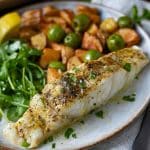
Greek Air Fryer Halibut
An easy Greek-inspired recipe made with fresh halibut, Greek seasoning, olive oil, lemon zest, and olives. Ready in 15 minutes or less!
Servings 2
Calories 219kcal
Equipment
- Air Fryer
- Parchment air fryer liners *optional, but I love these for tender fish recipes
Ingredients
- 12 oz fresh halibut fillets completely thawed and patted dry, if frozen (I use two 6 oz fillets)
- ½ tbsp olive oil
- 1 tsp Greek seasoning Cavender's recommended
- ½ tsp coarse salt *Cavenders has salt included, so feel free to salt after cooking to taste
- ½ tsp fresh lemon zest
- ⅓ cup pitted Castelvetrano olives or kalamata (olives are optional-but amazing)
- olive oil spray
- Lemon wedges and fresh parsley or dill for serving
Instructions
- Spray the air fryer basket with olive oil spray.
- Pat the fish dry with a paper towel and brush with olive oil on both sides.
- Sprinkle each halibut fillet with the Greek seasoning, salt, and lemon zest.
- Place the fillets in the air fryer and add the olives around the fish.
- Lightly spritz with olive oil spray and air fryer at 350 degrees for 8-10 minutes (depending on thickness) until just opaque. I typically pull it around 138 degrees F. (temp should rise a bit as the fish rests). Served fish should reach a safe temp of 140-145 degrees F.
- Serve fish with lemon wedges, and chopped fresh parsley or dill, if desired.
- Oven roasted option: Heat oven to 450 degrees. Prepare fish as directed above and place the fish in a shallow baking dish. Top with a few thin lemon slices and a drizzle of olive oil. Bake until just opaque, about 10 minutes. Serve with garnishes, if desired.
Notes
- Pat dry. Don’t forget to pat the fish dry with paper towels before coating it in oil and seasonings. This is key to achieving that coveted crisp on the outside during air frying.
- Preheat the air fryer. Preheating the air fryer for a few minutes before cooking fish is optional but a helpful hack to help with the initial searing and to promote even cooking.
- Mindful seasoning. Season the halibut so it’s fully coated with spices, but don’t go overboard. Too much seasoning may overpower the delicate flavor of the fish.
- Check for doneness. Use a food thermometer to ensure the internal temperature reaches a safe 140-145°F. Remember that the fish will continue to cook slightly after it's removed from the air fryer, so it's best to remove it a few degrees shy of the target temperature. I like to pull it between 135-138 degrees for our texture preference. Even though 145 is recommended for food safety, if borders on too tough for my liking.
Nutrition
Calories: 219kcal | Carbohydrates: 1g | Protein: 32g | Fat: 9g | Saturated Fat: 1g | Polyunsaturated Fat: 1g | Monounsaturated Fat: 6g | Cholesterol: 83mg | Sodium: 1048mg | Potassium: 750mg | Fiber: 1g | Sugar: 0.1g | Vitamin A: 203IU | Vitamin C: 1mg | Calcium: 25mg | Iron: 0.4mg